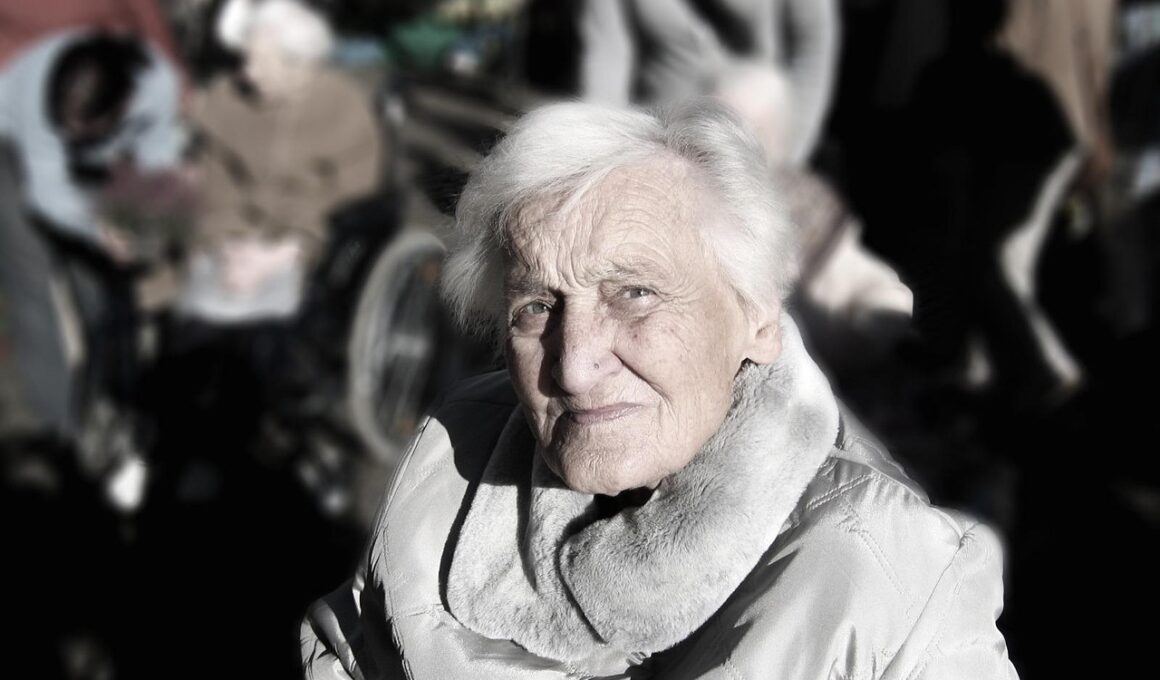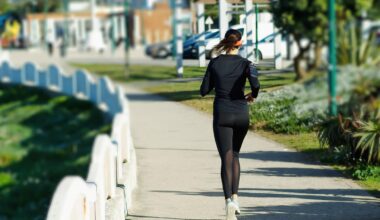Creating a Personalized Fitness Routine That Excites You in Later Life
As we age, finding motivation for fitness can become a daunting task, yet it is essential for enhancing overall health and well-being. Understanding the personal rewards of fitness helps create a thriving mindset. First, consider what excites you. Whether it’s dancing, walking in nature, or yoga, engaging in enjoyable activities fosters a sense of excitement. Incorporating variety is crucial to maintain interest. Try to blend strength training, cardiovascular exercises, and flexibility routines. Setting clear, achievable goals can also improve motivation significantly. Track your progress, and celebrate small milestones to stay encouraged. Try incorporating social elements into your routine; joining a class or group provides a supportive community. Realistically, everyone’s fitness level is different, so listen to your body and adjust accordingly. Remember, it’s perfectly fine to seek professional advice for a tailored fitness plan. A fitness journey in later life is not just a phase; it’s a lifestyle change that can lead to greater longevity and happiness. Staying active should be seen as an opportunity, not a chore. By personalizing your routine, you can unlock the vibrant and energized version of yourself.
One vital aspect of creating a personalized fitness routine involves understanding your body’s unique needs and limitations. At this stage of life, it is imperative to be aware of any health concerns or physical restrictions that may affect your exercise choices. Before diving into a fitness program, consider consulting with your healthcare professional. They can provide advice based on your medical history, ensuring that your routines align with your health goals. Focus on low-impact activities, especially if you have joint issues or other ailments. Swimming or cycling can deliver excellent cardiovascular benefits while being easy on the joints. Additionally, prioritizing flexibility and balance exercises is essential to avoid injuries and enhance mobility. Pilates or tai chi is great options to consider. Incorporating strength training helps maintain muscle mass, which naturally decreases with age, is vital in promoting functional independence. Personalize your workouts to include your favorite activities but ensure they foster improvements in strength, endurance, flexibility, and balance. Document your journey using a fitness journal, noting achievements and experiences along the way. Sharing your progress can also motivate and inspire others in similar situations.
The Role of Mindfulness in Fitness
Integrating mindfulness into your fitness routine can enhance the overall experience while ensuring you remain motivated. Engaging in mindful exercises means paying attention to the sensations and feelings present during workouts. It transforms a routine workout into a reflective practice that promotes both physical and mental well-being. For example, while doing yoga or Pilates, focus on your breath and the connection your body has with movement. This awareness allows you to understand your limits better and appreciate your progress. Mindfulness practices like meditation can also support fitness motivation. Taking a few minutes each day to center yourself can lead to increased focus, reduced stress, and a greater desire to stick with fitness goals. Developing a positive mindset fosters consistency and resilience, enabling you to overcome challenges more effectively. By cultivating a loving relationship with fitness, you’ll find it less daunting and more enjoyable. Incorporate regular check-ins with yourself, reflecting on what you enjoy and what brings you joy in your exercise routine. Remember, fitness is not just about the outcomes; it is about enjoying the journey and nourishing your body and soul.
Creating a supportive environment can dramatically influence your motivation for fitness in later life. Surround yourself with uplifting people who share your interests, as they can encourage you to stay active. This could include friends or family, or even community members with similar goals. Consider exploring local fitness classes or groups that welcome older adults. Establishing connections with others can bring a sense of accountability that pushes everyone forward. Social engagement through fitness not only provides motivation; it also enhances mental health and combats feelings of isolation. Don’t hesitate to join online communities or forums tailored for older adults. Sharing experiences, tips, and successes with others can create a supportive network eager for growth. Additionally, investing in proper equipment and wear that makes you feel good can also impact your motivation positively. When your gear is comfortable and suits your style, you’re likely to feel more inclined to work out. Build a workout space at home that feels inviting and inspiring. Personalize it with motivational quotes, photos, or music that inspires you. This space will serve as a reminder of your commitment to fitness and overall well-being.
Setting Realistic Goals
When embarking on a fitness journey in later life, establishing realistic and attainable goals is critical in maintaining motivation. Start by assessing your current activity level and determining where you want to go. Whether your goal is to walk a certain distance, attend a weekly class, or improve flexibility, it’s crucial to ensure that the goals are evidence-based and achievable. Break down larger goals into manageable steps that gradually build toward your ultimate objective. For example, if your aim is to walk five kilometers, start with shorter distances and gradually increase your stride as you grow more comfortable. Tracking your progress also plays a vital role in staying motivated; consider using a journal, fitness app, or watch to monitor your improvements. Celebrate these small victories, as they often lead to greater achievements. Sharing these goals with friends and family can create a supportive atmosphere. Working together and holding each other accountable is profound. Remember, goals can be adjusted as needed, and it’s perfectly fine to reflect on your progress and make changes if you feel it’s necessary or beneficial.
Building a balanced routine involves incorporating various types of exercises that promote overall fitness in later life. Cardiovascular activities can enhance heart health and endurance, so consider integrating these exercises into your weekly schedule. Brisk walking, cycling, or swimming are excellent options that can be adjusted to fit your fitness level. Aim for at least three days a week of cardiovascular exercise. In addition to cardio, strength training should not be overlooked, as it helps maintain muscle mass. Utilizing resistance bands, free weights, or bodyweight exercises can yield great results without the need for a gym. Aim for two days a week of strength sessions focusing on major muscle groups. Flexibility and stretching exercises are also vital components of a comprehensive fitness plan. Incorporating yoga or dedicated stretching routines can improve mobility and reduce injury risk. Lastly, don’t forget about balance exercises, which are crucial for preventing falls. Tai chi or simple balance drills can go a long way in enhancing stability. Tailoring your routine to cover all these facets ensures a holistic approach to fitness, enhancing strength, flexibility, and overall well-being.
The Importance of Nutrition
While creating a personalized fitness routine is essential, nutrition plays an equally critical role in maximizing your health as you age. A well-balanced diet fuels your body and supports your fitness activities. Focus on incorporating a variety of nutrient-dense foods, including fruits, vegetables, whole grains, lean proteins, and healthy fats. These food groups provide the essential nutrients that fuel your workouts and promote recovery. Stay hydrated; drinking adequate water is crucial for sustained energy levels. Refrain from excessive processed foods, as they can diminish your workout effectiveness. Regularly meal prepping can save time while ensuring you always have healthy options available. Consider exploring online resources for healthy recipes and cooking tips tailored for seniors. If you struggle with certain dietary restrictions or health concerns, consult a registered dietitian for personalized advice. Tailoring your nutrition to support your fitness routine will help navigate the common energy slumps associated with aging. Remember that nutrition isn’t a one-size-fits-all; pay attention to how different foods impact your body and adjust accordingly. Combining a tailored fitness routine with nutritious eating habits ensures that you thrive in your later years.
Your fitness journey in later life can be a fulfilling endeavor filled with excitement and growth. Both fitness routines and nutrition must be aligned to enable your body to function optimally. Embrace this incredible opportunity to build a lifestyle tailored to your preferences, values, and health needs. Every small change you make can lead to significant benefits, so remember to enjoy the process rather than focusing solely on results. Surrounding yourself with a supportive community and actively engaging in various activities will help you stay motivated. It is essential to remain flexible and open to adjustments to your routine as your abilities may change. Keep tuning in to your body, paying attention to signals it sends. Aligning your fitness routine with enjoyable activities makes this transformative journey all the more worthwhile. Ultimately, your health and happiness are the ultimate rewards. It’s not just about remaining fit; it’s about leading a vibrant and fulfilling life filled with joy. With a personalized fitness plan centered around motivation and enjoyment, this chapter of your life promises to bring you endless possibilities. So, step into your fitness adventure with enthusiasm and passion, for the best is yet to come!


